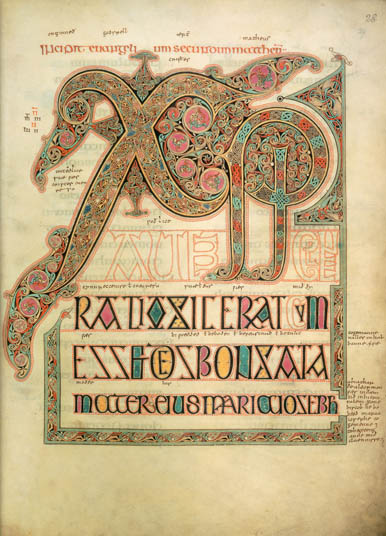The Ravaging of Lindisfarne
One story is that the Vikings first arrived in England in 789 on the Isle of Portland, off the southern coast of Wessex and responded by what was essentially a request for identification papers by slaughtering the person making the request.
Northumbria's King Oswald had commissioned the construction of the Lindisfarne monastery. An Irish monk named Aidan (from Iona, site of another monastery) made it happen and served from the founding, in 635, until his death in 651. A subsequent bishop named Finian built a wooden church. Other men built other buildings, and religious studies and reflection abounded. The famed Cuthbert, a man known around England for his great piety and many miracles, was bishop there as well; in fact, he had died there and his body was there when the invaders arrived. Lindisfarne in the 8th Century was famous and rich. Cuthbert's bones were a particular destination for many people, pious and otherwise. Lindisfarne also enjoyed the favor of the Northumbrian king and of the Northumbrian wealthy. Donations to monasteries came often and consisted of not only money but also things, like jewel-encrusted crosses and sumptuously decorated tapestries. To raiders not entirely familiar with the distinction between religious settlements and non-religious settlements, the attraction of Lindisfarne might have been entirely an economic one, without the stigma of religious desecration attached. In any case, the violence was swift and sure. Monks were stabbed or drowned. Women and children were killed or carried off in chains. Priceless manuscripts and relics were stolen or destroyed.
Historians know some of the details of what happened because of the writings of Alcuin, a scholar and theologian from York. Alcuin was serving in the court of Charlemagne at the time of the Lindisfarne attack, but he found about it through his network of religious friends and wrote to Northumbria's king, Ethelred I, with some horrid details: "Behold the church of St Cuthbert spattered with the blood of the priests of God, despoiled of all its ornaments; a place more venerable than all in Britain is given as a prey to pagan peoples." It was not the last such attack. The monastery at Jarrow, home to the famed Venerable Bede, was sacked, the following year. Iona, another holy site, was a target three times. Alcuin, in a letter to Bishop Higbald of Lindisfarne, hinted at a divine retribution being brought upon the English by the Danes: "What security is there for the churches of Britain if St Cuthbert with so great a throng of saints will not defend his own? Either this is the beginning of greater grief or the sins of those who live there have brought it upon themselves." The raids continued. More ships carrying more men came more frequently. The Danish invasion had begun. |
|



 What is known for certain is that raiders arrived in force on June 8, 793 and sacked the holy monastery at Lindisfarne, off the coast of Northumbria, bringing death and destruction.
What is known for certain is that raiders arrived in force on June 8, 793 and sacked the holy monastery at Lindisfarne, off the coast of Northumbria, bringing death and destruction.  The relics of Cuthbert emerged unscathed, as did the painstakingly handwritten and illustrated Lindisfarne Gospels, an illuminated copy of the first four books of the Christian Bible's New Testament. (The Cuthbert relics survive in Durham Cathedral; the British Museum houses the Lindisfarne Gospels.)
The relics of Cuthbert emerged unscathed, as did the painstakingly handwritten and illustrated Lindisfarne Gospels, an illuminated copy of the first four books of the Christian Bible's New Testament. (The Cuthbert relics survive in Durham Cathedral; the British Museum houses the Lindisfarne Gospels.)
